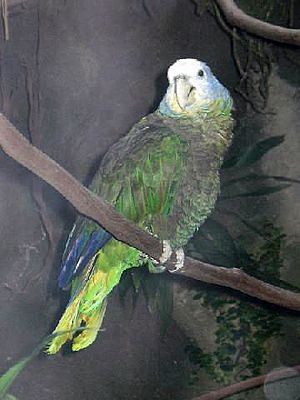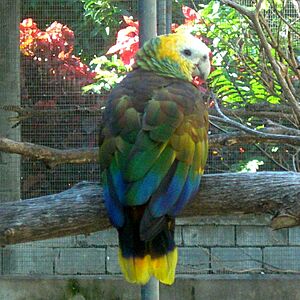Saint Vincent amazon facts for kids
Quick facts for kids Saint Vincent amazon |
|
|---|---|
 |
|
| Saint Vincent amazon | |
| Conservation status | |
| Scientific classification | |
| Kingdom: | |
| Class: | |
| Order: | |
| Superfamily: | |
| Family: | |
| Subfamily: |
Arinae
|
| Tribe: |
Androglossini
|
| Genus: | |
| Binomial name | |
| Amazona guildingii |
|
The Saint Vincent amazon, also called the Saint Vincent parrot, is a special type of parrot. It is the only parrot that lives on the island of Saint Vincent in the Caribbean Sea.
This parrot is quite large and has many bright colors. Its head can be yellowish-white, blue, and green. Its upper body feathers are a greenish-bronze, and its wings are a beautiful violet-blue-green.
Contents
About the Saint Vincent Amazon

This amazing bird is about 40 cm (16 in) long. Its feathers are very unique, meaning almost no two birds look exactly alike! They have a head that can be yellowish-white, blue, and green. Their upper body is greenish-bronze, and their wings are violet-blue-green. They have grey feet and reddish eyes. Both male and female parrots look similar.
There are two main color types, or morphs, of this parrot. The most common one is called the 'yellow-brown' morph. The other, less common, type is the 'green' morph. While they look mostly alike, the 'green' morph has a dull-green upper body and a bluish-white head.
Where They Live
The Saint Vincent amazon lives only in the forested mountains of the Caribbean island of Saint Vincent. This means it is endemic to that island, so you won't find it naturally anywhere else!
These parrots prefer to live in the rainforests found in the island's central mountains. They can be found from about 125 to 1,000 m (410 to 3,281 ft) high. They especially like mountains and valleys that are not too high up. This is because these areas have bigger, older trees, which are perfect for building their nests.
Life and Habits
Saint Vincent amazons usually live in groups. They like to eat in the upper parts of tall trees. Their diet is mostly made up of fruits, seeds, flowers, and leaves from different plants in the rainforest.
They breed between January and June, with most babies born from February to May. They make their nests in holes found in large, old trees. The female parrot usually lays two or three eggs.
Why They Need Our Help
The number of Saint Vincent amazons went down a lot during the 20th century. This happened for several reasons:
- Their homes (forests) were destroyed, which is called habitat loss.
- Some people hunted them for food.
- They were captured to be sold as pets.
- Natural disasters like volcanoes and hurricanes also caused problems.
Because of all these things, the Saint Vincent parrot is now considered Vulnerable. This means it is at risk of becoming endangered. It is listed on the IUCN Red List of Threatened Species, which is a list of animals and plants that need protection. It is also protected by CITES, an international agreement that controls the trade of wild animals and plants.
Protecting the Parrots
Many efforts have been made to save the Saint Vincent amazon from disappearing. These conservation actions include:
- Making sure laws are followed that stop hunting and trading these parrots.
- Protecting their home by creating the St Vincent Parrot Reserve.
- Teaching people about the importance of protecting these birds through public education programs.
On October 27, 1979, the Saint Vincent amazon was made the national bird of St. Vincent and the Grenadines. This was part of the country's first independence celebration!
- ARKive - images and movies of the Saint Vincent Amazon (Amazona guildingii)
Images for kids
See also
 In Spanish: Loro de San Vicente para niños
In Spanish: Loro de San Vicente para niños




